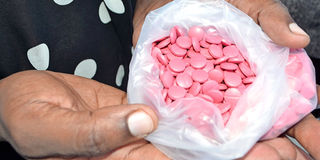Campaign aims to boost iron intake among women

Iron supplements are taken to prevent deficiency which may cause anaemia especially among women of childbearing age. PHOTO| FILE
Juliana Natumoi has not been keen in providing vegetables during meal times. In her Maasai community, a good meal is characterised by plenty of beef.
Vegetables are associated with poverty and make good fodder for livestock. But recently while in hospital, Ms Natumoi was told she didn’t have enough blood.
“I was told to take lots of green vegetables to boost iron levels,” she says.
And though red meat is also a source of iron, locals have been overcooking it, making it less nutritious.
Ms Natumoi is not alone, Narok County where she hails from has the highest prevalence of iron deficiency in the country, according to a joint assessment report on adolescent nutrition policy and programming in Kenya released by the Ministry of Health, the World Food programme and Unilever in April 2018.
Trans Mara West Sub County Nutritionist Norah Mokire says one out of every four women of reproductive age in the region are anaemic. Close to a quarter of women and half of pregnant women in Kenya have anaemia.
According to the report, micronutrient deficiencies are highly prevalent in Kenya, particularly zinc, iron, and vitamin A. From the data, iron deficiency was the highest contributor to the high anaemia rates amongst all highlighted vulnerable groups, pointing to poor dietary iron intakes among these populations.
Ms Mokire says women in their childbearing years are at higher risk for iron deficiency because of the loss of blood during menstruation.
DEFICIENCY
Lack of iron leads to extreme fatigue and exhaustion, frequent infections, pale skin, swollen tongue and hair loss.
Also, it causes ‘Restless Legs Syndrome’ which is a disorder that causes people to have a strong urge to move their legs. The urge often comes with an unpleasant, crawling sensation in the legs that can make it hard to sleep.
People with iron deficiency may develop cravings for non-food substances, such as clay, dirt, or chalk, a condition known as pica.
Over the weekend, efforts to combat iron deficiency in the country received a boost with the launch of a behaviour change campaign encouraging the cooking of iron-rich foods.
The campaign, dubbed Get Your Iron Up is aimed at encouraging nutritious cooking of iron-rich foods.
“Research shows that teenage girls and women suffer disproportionately from iron deficiency anaemia because of their unique physiological needs and due to low iron intake from foods,” said Godwin Bamsa, Unilever Nutrition and Health Foods Africa.
In the newly launched campaign, Unilever has embarked on a tour around the country recruiting women as Iron ladies who become champions for creating awareness and advocating positive behaviour change.
In addition to Narok, these engagements will be carried out in Kisumu, Nyeri, and Mombasa over a period of five months leading up to the World Food Day celebrations to be held in Nairobi in October.
“Our aim is to improve the nutritional value of commonly consumed dishes and, over time, increase the iron intake of the population to help decrease the prevalence of iron deficiency anaemia in Kenya,” said Bontle Modiselle, Royco Brand Manager, Unilever.
Unilever launched the behaviour change campaign accompanied by the use of the new Royco iron fortified cubes in the Kenyan market.
“Our commitment to the health and well-being of our consumers is evident in our bringing innovative food products to the market and in community engagement to sensitize the masses towards the iron deficiency challenge in the country as well as create preventative behaviour change through nutritious cooking,” said Ms Modiselle.
The campaign is in line with efforts to achieve Sustainable Development Goals whose focus is to end hunger, achieve food security and improved nutrition, and promote sustainable agriculture.
It touches specifically on aims to end all forms of malnutrition by 2030, including achieving by 2025 the internationally agreed targets on stunting and wasting in children under five years of age, and address the nutritional needs of adolescent girls, pregnant and lactating women, and older persons.



